Our Top 10 Tips to Increase Your Ranking in Google SERP
If you manage a multifamily property, you know how important it is to be visible online. After all, potential residents will likely start their search for a new place to live by turning to the Internet. But with so many properties vying for attention, how can you ensure that yours stands out from the rest? The answer is multifamily SEO.
SEO, or search engine optimization, is improving your property’s ranking in Google and other search engines. Following a few simple tips, you can ensure that your property appears at the top of the search results when potential residents are looking for a new place to live.

Solving the Mystery of Multifamily SEO
The mysterious art that is multifamily SEO is not that mysterious at all. From this perspective, things become a little clearer when we think about multifamily SEO. We all do searches and all happen across results less than valuable to our needs.
Google only cares about one thing and one thing. Relevance. That is it — just relevance. They do not care about you or your multifamily business — they only care about the person searching.
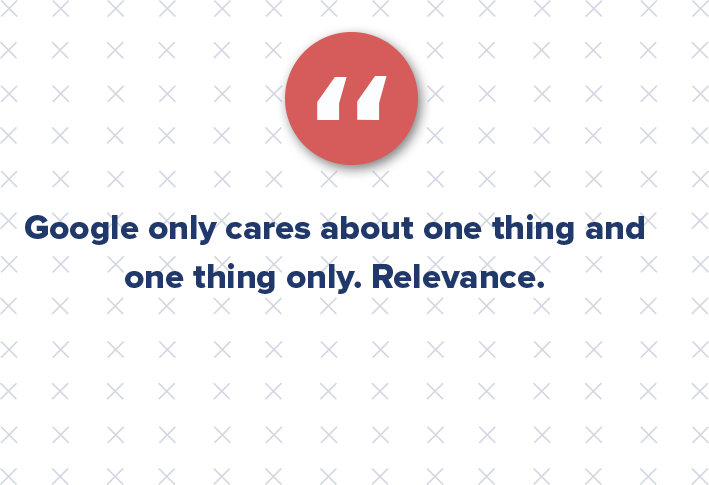
Google’s job is to get the user the best results as quickly as possible. It is not easy when so many people are trying to game the system to increase traffic to their site. Google gives us one directive, “Be Relevant.”
From time to time, you hear about Google’s major algorithm updates and descriptions of what they do from a technical standpoint. You need to know less of the technical aspects and more of the overarching strategy — relevant content. If you can follow that advice and do it well, you will find yourself rising in the ranks of Google.
So you want to know how to do it well? Do you want to know the secret to get your multifamily business listed?
Just follow these SEO tips to improve your ranking in Google:
1. Create remarkable content
Remarkable content is sharable content. You want your content to be so good that people want to share it with their friends, families, and others within their circle of influence. This, while a little daunting, may be simpler than you think. You can start by identifying pain points that your prospective renters may have and give them a solution.
Your content shouldn’t be about driving a sales pitch, it should be about educating. Add value to your viewers. They will appreciate it, and in turn, pass it around to those within their circle of influence.

2. Create a catchy, relevant headline
Your headline is your first impression, and first impressions count. It’s just as important as having a strategic meta description and title tag. You want your headline to be catchy and engaging but also contain your primary keywords.
Try using numbers combined with the primary keyword you are trying to rank for. People are drawn to lists because they are faster reads, such as:
- 5 Ways to Decorate Your Luxury Apartment in Dallas
- 10 Steps to Declutter Your One-Bedroom Apartment
- 30 Things to Do in Charlotte, N.C. This Summer.”

3. Always include a call-to-action (CTA)
Throughout your blog, or at least at the end of it, provide a way for your viewers to get more helpful information by providing you with a little bit of information. Give them something of value for providing you their name and emails, such as a whitepaper on the “Top Multifamily Market Trends of This Year,” an infographic on “What Amenities Your Residents Really Want,” or perhaps an eBook on how to win more business by using your multifamily product or service. (Psst … a great example of a marketing offer is the one you see promoted throughout this blog!)
This is one way to help identify which content is truly remarkable and what is not. When someone fills out your form requesting additional information, this is what we like to call an apartment lead — it shows interest!
4. Distribute your multifamily content
Simply put, don’t just post content to your site and leave it at that. Get the word out. Post a link across your social channels, send it out in an email blast, and get your coworkers and others in your circle to post it. This will create a buzz around your multifamily business, and you will start seeing a spike in traffic to your site just because of this. Every post you make needs to include social sharing icons, making it easy for your viewers to share it. The easier it is to share, the wider your reach.
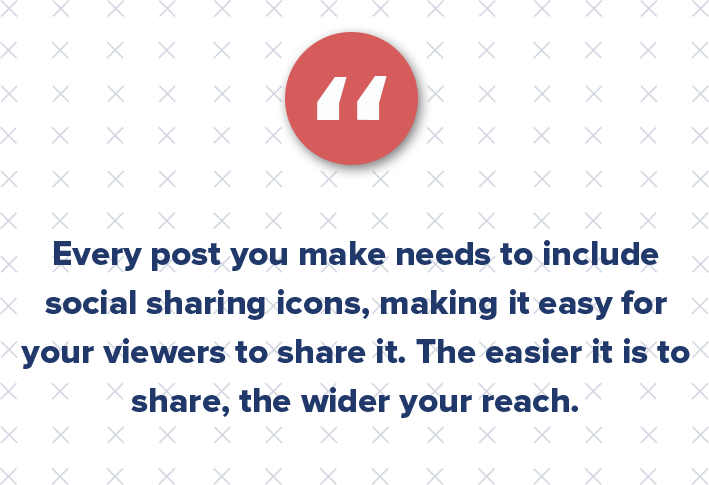
5. Enhance your outreach backlink strategy
Distributing your content is also a great strategy for enhancing your backlink strategy. A backlink is a link from another website to your multifamily website, web page, or web directory. This is comparable to a citation. These backlinks are critical to any good multifamily SEO strategy as it shows Google that your multifamily website has authority and relevance in the market.
By getting the word out about a new blog you published, for example, you increase your chances of similar websites linking back to your content and increasing your authority with Google (and thus, your ranking!) Distributing your content and reaching out to similar publications are two easy (and free) ways to increase your backlinks.
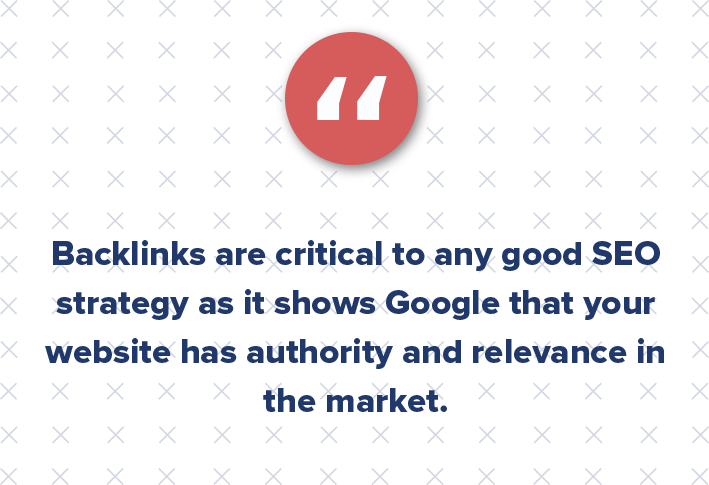
Just be very cautious about blackhat multifamily SEO tactics that could harm your rankings, such as irrelevant and spammy backlinks.
6. Encourage commenting and respond to comments
This point is not that hard, invite viewers of your content to leave you feedback through comments. This provides a great way to build relationships with prospects interested in using your multifamily product or service. These comments can come from social media or your multifamily website.
7. Claim your Google Business Profile
Google Business Page (formerly Google My Business) is a free service offered by Google that allows businesses to manage their online presence. When you claim your listing, you can control what information appears about your property when it comes up in a search. Ensure all of your property’s information is accurate and up-to-date, and take the time to respond to positive and negative reviews.
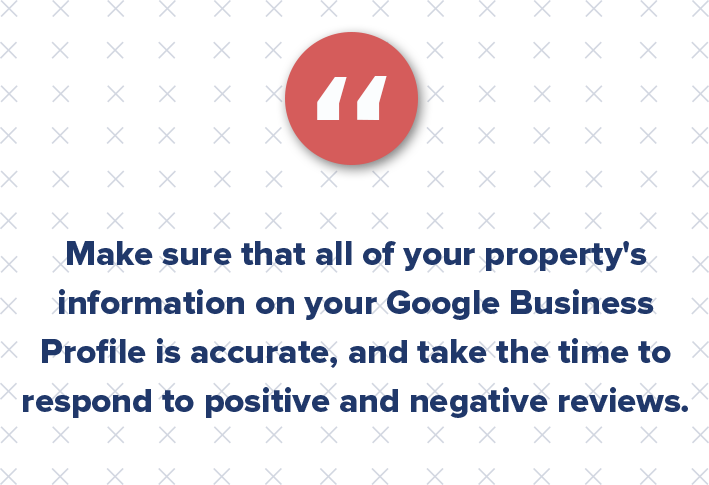
8. Optimize your multifamily website for SEO
Your multifamily website should be designed with SEO from the beginning. That means incorporating relevant keywords into your content, ensuring your site is easy to navigate, and ensuring all your content is original and error-free. You should also ensure that your site is mobile-friendly, as more and more people use their phones and tablets to access the internet.
9. Get involved in local community events
Local community events are a great way to get your property’s name out there. Sponsor a Little League team, host a food drive or partner with a local charity. Anytime you can get your property’s name in front of potential residents, you’re increasing the chances that they’ll remember you when they’re ready to start looking for a new place to live.
10. Make use of social media
Social media platforms like Facebook, Twitter, Pinterest, and Instagram are great ways to connect with potential residents and create an engaged online community around your property. Use social media to share your property’s news updates, highlight available units, and promote community events.
And don’t forget to respond quickly and courteously to any questions or concerns posted on your social media accounts — you want potential residents to know they can count on you for excellent customer service.
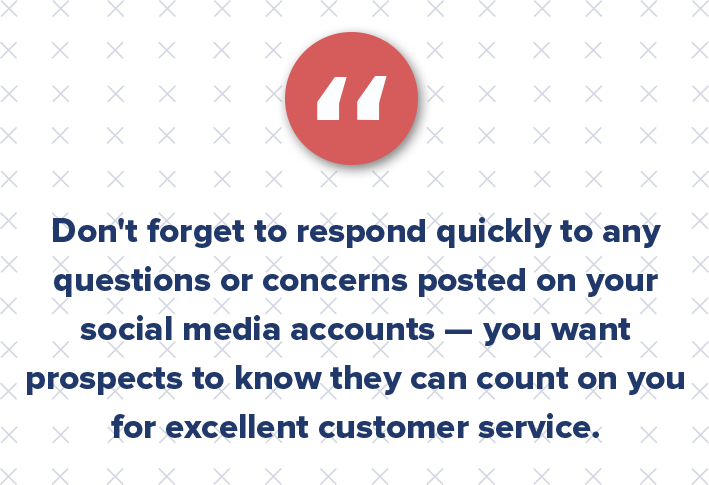
Writing Remarkable Content to Earn Higher SERP Rankings
To sum up, there is nothing magical about these SEO tips. As a wise man once said, “If it is not worth doing right, then it’s not worth doing.” Writing remarkable content to improve your multifamily SEO takes time and effort, but it ultimately pays off.
Following these simple SEO tips can improve your multifamily property’s ranking in Google and attract more attention from potential residents. Investing in SEO will pay off in the long run as you see an increase in traffic to your website and ultimately lease up more units at your property.

The Secret to a Successful Multifamily Marketing Strategy: Influencer Marketing
Millennial and Gen Z renters no longer consider commercials or ads the major influence in their decision-making process. Many brands know this, using their marketing tactics to focus on influencer marketing to reach beyond the typical leasing billboard.
From reviews to thought leadership, social media for apartments offers a unique outlet to build fans as an influencer. Social media influencers in the real estate world are recognized for their large following and insights covering all aspects of the multifamily space.
A strong social presence is necessary to hold an influencer status in addition to quality posts. Turning to these influencers as a voice within the industry will result in valuable relationships that companies can leverage.
So who exactly are these valuable assets?
Social media influencers are users with a large following and are “influencing” the community. They are often viewed as a more trustworthy resource than advertisers, thus better capturing an audience.
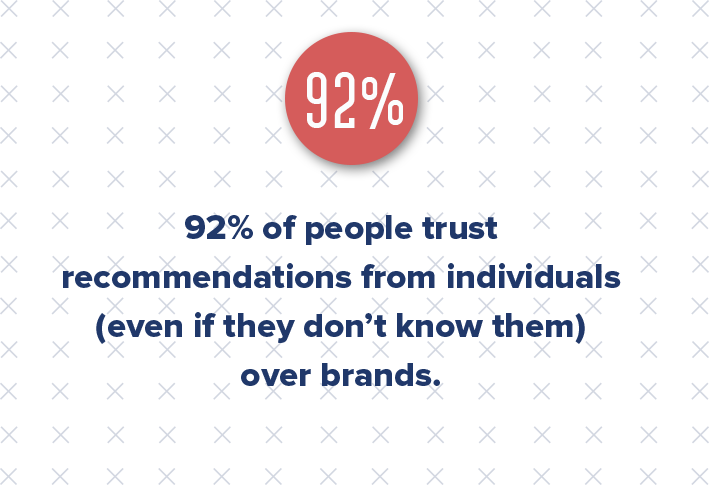
According to Nielsen, 92% of people trust recommendations from individuals (even if they don’t know them) over brands. It makes sense, right? Who sounds more reliable, a brand trying to sell you something or an individual just stating opinions?
Influencer marketing has become an increasingly important tool for businesses in recent years, and the multifamily industry is no exception. Influencers are social media users with a large and engaged following who can help to promote your brand or product. When done correctly, influencer marketing can be an extremely effective way to reach new prospects and generate apartment leads.
What does influencer marketing mean for multifamily?
As property managers take to more nontraditional methods for reeling in renters, social media influencers hold an interesting opportunity for multifamily. Influencer marketing is an indispensable asset as it allows a third party to promote your property.
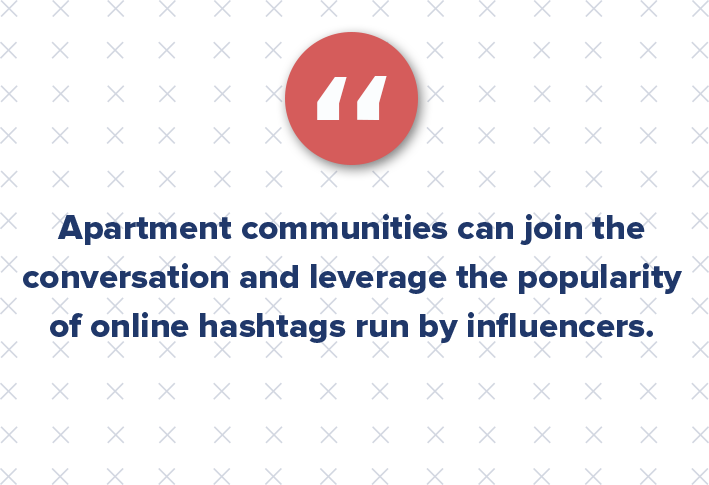
For instance, influencers have brought attention to properties through guest blogging and social promotion, like TweetChats. Most of them participate or host weekly Tweetchats, like #AptChat and #REOnline, where real estate professionals exchange ideas while networking. Apartment communities can join the conversation and leverage the popularity of online hashtags run by influencers.
Leveraging influencer marketing for your property
There are a few key things to remember when leveraging influencers for social media.
- First, it’s important to identify influencers who are a good fit for your multifamily brand and who have an audience that overlaps with your target market.
- Second, you’ll want to develop a clear strategy for working with influencers, including what type of content you’d like them to create and how you’ll promote it.
- Finally, ensure you measure the results of your influencer marketing campaign to continue improving your multifamily marketing strategy over time.
Connect and Engage With Influencers
Connecting with real estate professionals is the first step to becoming aware of how influencers can help your marketing. Engaging with these professionals in relevant topics will help develop a network that can be used to get involved with the community.
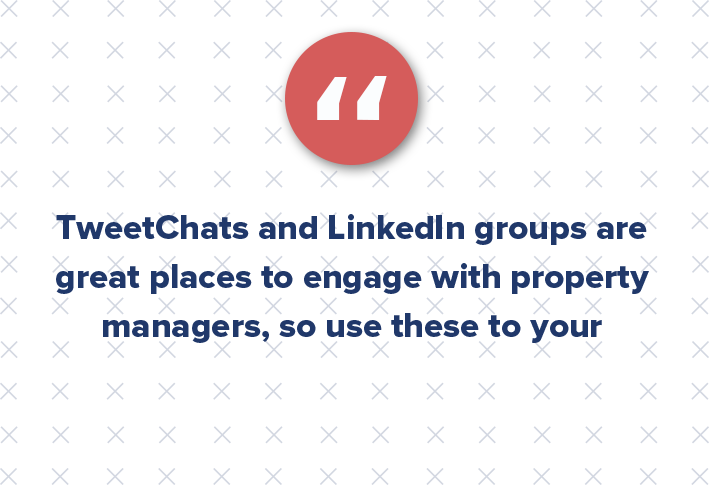
Twitter, Pinterest, and LinkedIn have a large commercial real estate community, so it’s important to know where to go to connect with the right professionals. TweetChats and LinkedIn groups are great places to engage with property managers, so use these to your advantage. As long as you’re getting your name out there, other professionals will start to see you as a reputable source.
Socialize With Quality
Focusing on sharing quality content is important to real estate influencers. Social media should be an outlet for property managers to be themselves and talk with other professionals. Sharing relevant content and using popular real estate hashtags will elevate your presence. Further, voicing opinions on certain trending topics will show a positive interest in building an active, involved community.
Boost Your Multifamily Marketing Efforts
Influencers are great marketing tools because they know the ins and outs of the industry. Connecting with these professionals allows property managers to market their property simply by becoming visible to their followers.
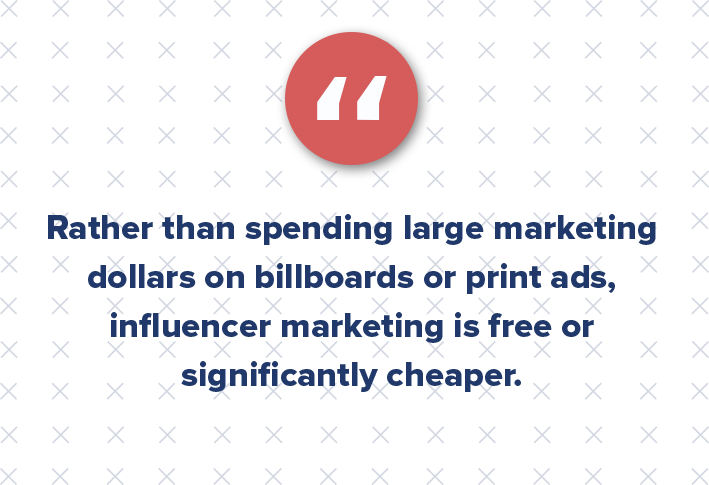
Rather than spending large marketing dollars on billboards or print ads, influencer marketing is free or significantly cheaper. Consider allowing one of these professionals to guest blog on your property’s site, for example. They can share your article with their followers, and you have more content to add. It’s a win-win!
By following these tips, you can maximize the impact of influencer marketing for your multifamily business.
Winning Tactics to Attract More Gen Z Renters to Your Property
The oldest members of Gen Z are turning 25 this year. They were only seven years old when Facebook launched; they had never known a time before the internet.
And guess what else? They will be the largest generation of apartment renters the industry has ever seen.
We just adapted to millennial renters, and now here comes Generation Z in full force. Before long, it will be time to adapt again to Generation Alpha (AKA “mini millennials”), but let’s not get too far ahead of ourselves.

Meet your Gen Z renters
First, who are your Gen Z renters? They’re the buzzed-about generation, and rightfully so, with $360 billion in disposable income. And Gen Z’s spending power is continuously on the rise.
While millennials have historically garnered all the attention from multifamily apartment properties, Generation Z has overtaken the rental market. This age group is typically born between the mid-1990s and 2010.
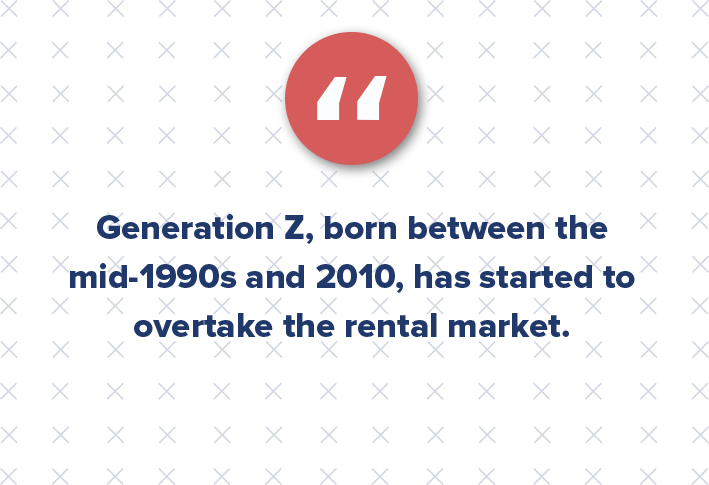
When comparing them to previous generations, online connectivity emerges as the defining characteristic. As such, this young population should be an extremely important part of your apartment marketing strategy.
Gen Z by the numbers
Let’s consider a few stats from a recent rentcafe.com survey of 2,500 Gen Z renters:
- 39% of Gen Z renters searched Google for their next apartment, while 27% specifically went to apartment search websites.
- 52% of Gen Z said they prefer non-agent apartment tours (e.g., self-guided or virtual tour options).
- 30% of this generation check ratings and reviews first, as compared with 28% of millennials and 25% of Gen X.
- 62% of Gen Z said apartment technology is either “extremely important” or “very important.”
- The No. 1 most important amenity to Gen Z renters is high-speed internet, followed closely by garage and parking.
- 36% of Gen Z renters said Instagram is their #1 social media platform.
- Smart locks and smart thermostats are twice as important to Gen Z as to millennials or Gen X.
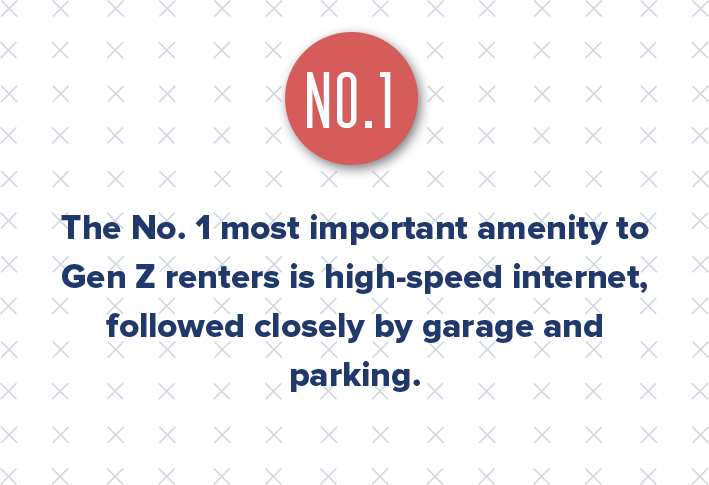
What do Gen Z renters want?
Gen Z renters seek efficiency in leasing, new communication channels, and enhanced amenities. As these young adults continue to enter the rental market, it will become increasingly crucial for you to understand their expectations.
1. Smart technology
Now is the time to get ahead on your smart apartment technology and high-speed internet connectivity, as these amenities are more important to Gen Z renters than gyms, pools, and coffee bars.
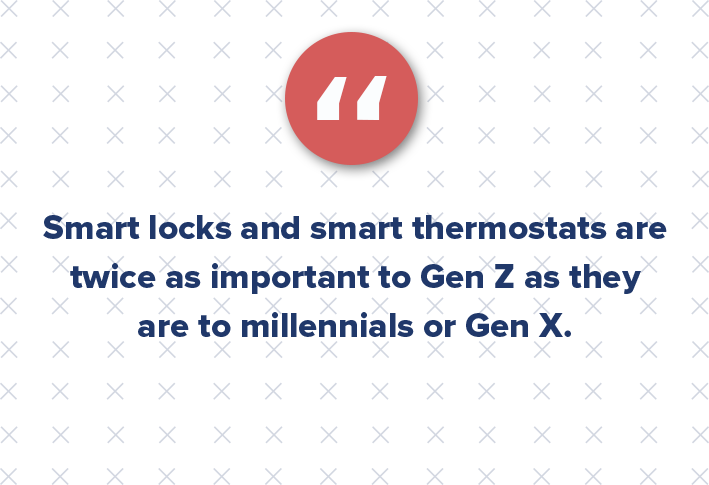
2. Mobile-first strategy
Gen Z’s technology use is fast-evolving in consumer marketing and the real estate industry. Smartphones are considered an extension of the body. Gen Z touches their smartphones 45 times daily for communication, entertainment, and informational purposes. About 29% of Gen Z are on their phones after midnight every night, and 31% said they feel uncomfortable without their phone for 30 minutes or less.
We don’t know what will if these stats don’t tell you to prioritize your mobile-first website!
3. More activity on social media
Social media is a natural forum for Gen Z to interact with friends and companies. In fact, their preferred method of communication is on social media rather than in person (even when it comes to their friends and family). This generation’s lifestyles and technology habits are causing us to rethink how we approach brand development, particularly in real estate.
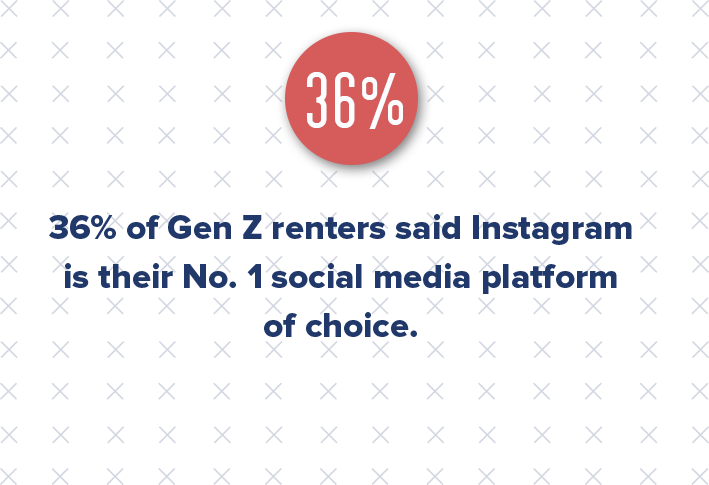
With technology at their fingertips, everything of interest to Generation Z is connected to social media. Your apartment marketing should focus extensively on the most popular social media platforms (i.e., Facebook, Instagram, Snapchat, and TikTok) and continually adapt as new social tools gain popularity.
While these young adults are known for their multitasking abilities when juggling various social platforms simultaneously, they are also known for “scrolling.” Your social media ads should, therefore, be attention-grabbing and specific. Hone in on your core message quickly or risk losing engagement. Focus your apartment marketing efforts on videos and other visually appealing content for the best results.
4. Rent longer. Rent by choice.
Aside from being the most coveted demographic, they’re also the most baffling for a traditional multifamily industry to understand. Compared to the generations before them, changing lifestyle preferences are beginning to propel several trends in multifamily development.
Gen Z is poised to rent longer than generations before, often by choice. If you compare it to the millennial generation, who waited longer to get married and start a family, Gen Z is expected to follow in a similar path. This trend will undoubtedly extend their rental lifetime well into their professional years.
5. More tour options and an adaptable leasing process
With over half of Gen Z renters preferring non-agent apartment tours, it will be up to your property to adapt and offer a mix of in-person, self-guided, and virtual tour options to increase conversions.
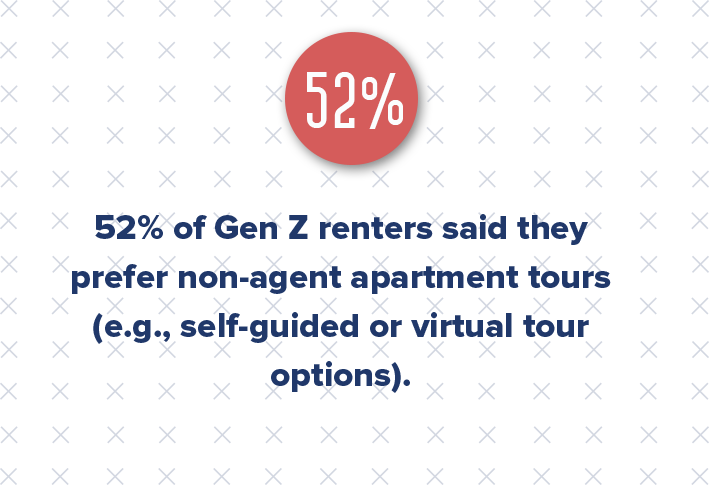
Regarding communication and the leasing process, a mobile-first strategy is also important. Gen Z is unlikely to hand-write a rent check or manually fill out a leasing application. They expect everything online, which includes leasing paperwork and payments.
Marketing to Gen Z renters
Gen Z lifestyle preferences drive key changes in multifamily development, but what does that mean for multifamily marketing? If you understand what’s important to them, you can understand how to attract them. This is how to maintain a customer-centric approach.
However, remember that being familiar with multifamily marketing trends is only a starting point. Your greatest demographic insights will come from the research you do yourself. The best way to research your target market is to develop resident personas. You can learn all about developing personas on our blog.
Again, when we know what’s important to prospective residents, we can understand how to attract and engage them.

Understanding the Relationship Between Multifamily SEO and Social Media
Did you know that multifamily SEO matters on social media?
More and more multifamily properties are hopping on social media, which serves as another channel for them to share and interact with renters and the community. But perhaps you don’t see the appeal of a social media presence?

Well, we’re here to give you another very important reason to be on social media, and that’s search engine optimization (SEO). Multifamily SEO is essentially the process of optimizing your content for search engines.
For most platforms (i.e., Instagram, Facebook, Twitter, Pinterest, and Tumblr, to name a few), there are a few simple steps you can take to move your multifamily property up in search engine rankings:
How do you optimize your social media profiles?
1. List Basic Information
All social media platforms have a place for users to list basic information: Company Name, Location, About Us, Address, etc. Make sure to fill out all the information sections on your profiles with specific keywords. The more information you share, the more chances you have to be indexed by Google. Besides, you want to make sure that anyone who comes across your property online knows exactly where it’s located and how to contact you.
2. Anticipate Popular Keywords
Brainstorm words or phrases that are relevant to your multifamily property. Perhaps it’s “lofts in downtown Dallas” or “Houston apartments with a dog park.” What is your property or multifamily business offering? What would your target audience search specifically? Use these keywords at a high density throughout your social media profiles and bios; include them in your social media captions when it’s natural to do so. You also might want to use them in hashtags (within the caption and not the comments) to get users on social media to find you more easily.
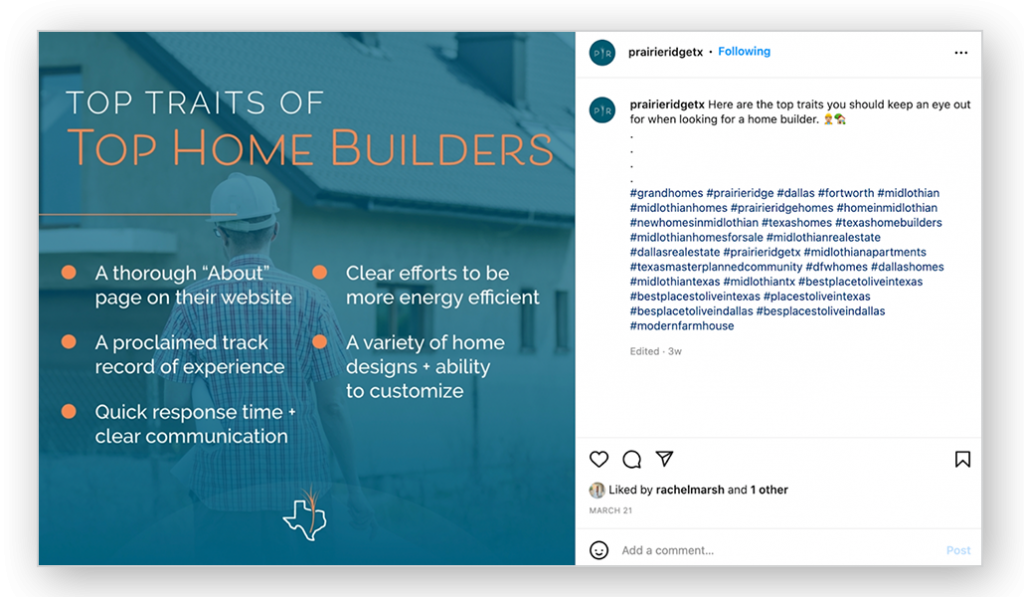
3. Invite Reviews
Display a section for reviews when possible. Facebook pages have a review section on the left side panel with 1-5 star ratings for the user to evaluate and post comments. It shows real people living in your multifamily property, providing real feedback. Again, it’s more opportunities to be indexed by search engines. This also allows you to publicly address any issues that your residents may be having, ultimately showing potential residents that you’re on top of handling problems.
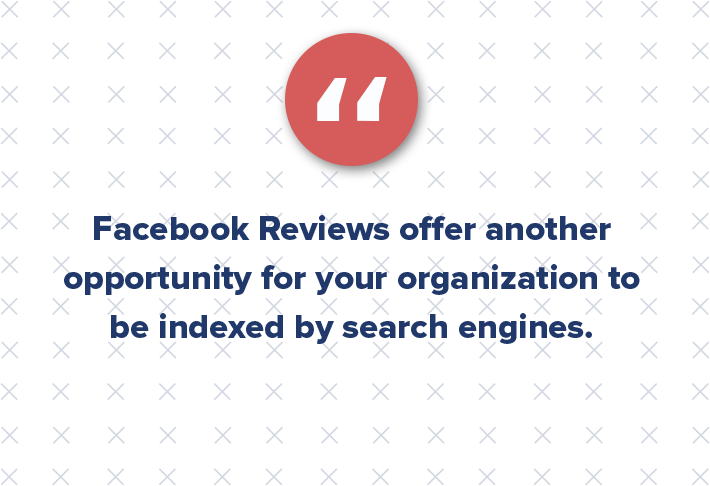
4. Link Often
Outbound links are one of the most important aspects to multifamily SEO, so be sure to link to other sources! In your use of social media, provide links to relevant blog articles and neighborhood events. Spread the word out about the great happenings going on around your neighborhood and property. Not only is it good for multifamily SEO, but “linking” is a great way to connect with people and businesses in your community.

5. Create Shareable Content
Inbound links are equally as important to SEO, yet you have to earn them. When people link back to your multifamily website or social media pages, it means you’re sharing content that is high quality, compelling, and helpful.
Some ideas include:
- Make and share a weekly newsletter with information about what’s going on at your property.
- Post interior design tips for small living spaces.
- Write about apartment decorating and storage hacks.
- Promote local events and happy hour specials in your community.
Creating shareable content starts with knowing your audience and what they would find interesting and resourceful.
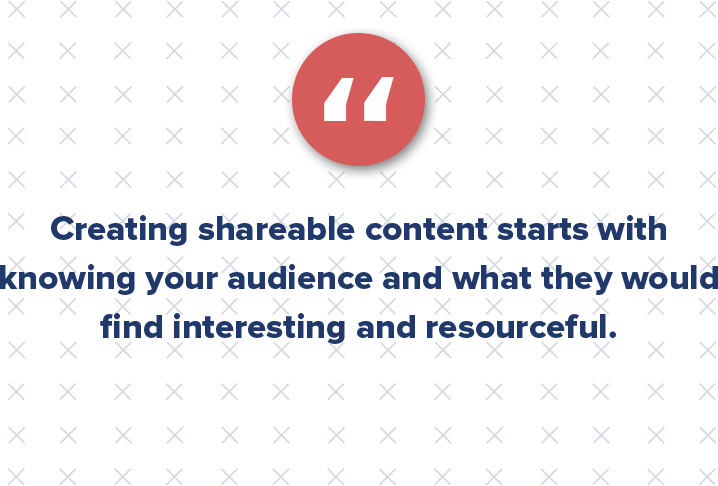
6. Utilize Multifamily PPC
While SEO is the organic approach to driving traffic, multifamily PPC is the paid. PPC ads display at the top or in the sidebar of search engine results. A successful multifamily PPC campaign combines your keyword research and your insights to design highly targeted ads that drive traffic to your website. It’s important to note that well-qualified traffic is the result of research and continued testing. Understanding your residents should be an ongoing learning process and the foundation of any SEO or PPC campaign (not to mention, all digital marketing).
7. Update Your Instagram Bio
Potential renters don’t just use Google to find new apartments, they use Instagram too. They go to the search bar on the explore page a type in “apartments in [city]” and maybe even include a descriptor such as “affordable” or “luxury.”
The way you give your property’s account the best chance of showing up in a related search is by adding keywords right into the “Name” of your profile’s bio. While the label for this section might make you assume you’re limited to just having your property’s name, there are actually no rules for this section. You can put whatever you want for your bio’s name. There’s also quite a bit of space you have to work with.
Here are some examples:
- Rio Villa Apartments | San Angelo, TX
- LVL 29 | Luxury Apartments in Plano
- Willow Creek | Affordable Apartments in Austin
- Prairie Pride | New Homes in Midlothian
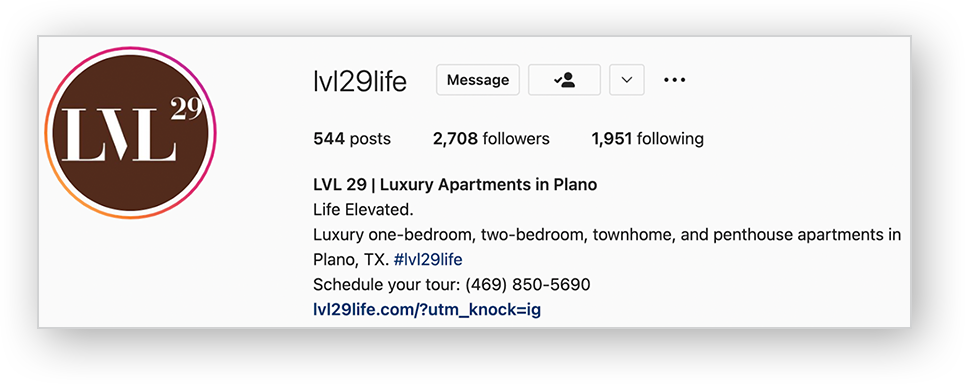
If you feel like your Instagram handle is enough to communicate the name of your property, you could even remove the name entirely and focus more on longer or multiple keywords.
Following these simple steps is a great way to improve your search engine ranking with the social media platforms you’re already using. It ultimately makes your content easier to find, allows you to connect with your audience, and helps you build the brand that you’re striving towards.

Creating Marketing Qualified Leads With the Right Form
The excitement of starting an inbound marketing strategy for your organization can lead to initial eagerness to get things rolling. But in that sprint to kick off your multifamily marketing, you might find yourself missing a step or two.

The use of content to gather apartment leads is, without a doubt, the primary focus of inbound. Therefore, many marketers and property managers spend their time emphasizing content strategy to generate those apartment leads.
However, optimizing your content without optimizing your lead strategy defeats the purpose of inbound altogether. Instead, marketers should spend much of their intro to the inbound process on apartment lead generation and business strategies to guarantee their content is meeting objectives.
What is the purpose of an apartment lead generation form?
Nearly every multifamily website these days has an apartment lead generation form. But the effectiveness of those forms depends on many factors, including:
- Type
- Location on the page
- The offer
- The questions
- How the contact data is used
Have you ever been interested in a new apartment complex or shopping center around town? Maybe you had a specific question while they were in development, so you filled out the contact fields — and waited. And waited. But no one got back to you.
Chances are, you provided a decent amount of personal information on that apartment lead generation form. You did so willingly because it was an exchange you found reasonable: your contact details for the offer or answers you wanted. Understanding this exchange is the key.
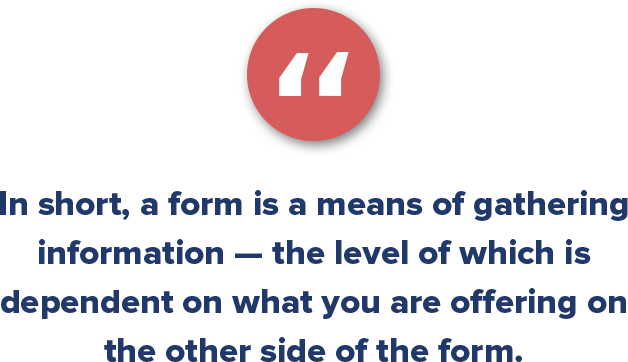
In short, an apartment lead generation form is a means of gathering information — the level of which is dependent on what you are offering on the other side. In multifamily inbound marketing, forms are also a means of progressive profiling (i.e., qualifying your apartment leads by asking for a little more intel) each time they fill one out. This progressive profiling is meant to get more and more information that qualifies leads by lifecycle stage and determines their point in the buyer’s journey.
What questions should you ask on your apartment lead generation form?
Now that you know the importance of your fields, the next issue becomes, “What questions should I ask?” This is where your apartment lead generation strategy comes in. If you followed the multifamily inbound marketing strategy correctly, your teams all came together to identify your buyer persona. Doing this should have resulted in defining your lead lifecycle stage.
If you have not done this, go back and do it now because this data is vital to your progressive profiling.
Let’s say you are a tenant representative for a large new commercial office building downtown. The project is not complete yet, but it has generated a lot of buzz, and companies are showing interest. You want to be sure you lease up before opening. However, you also need to make sure the companies you bring in are a good fit. This is where progressive profiling comes in.
Your first apartment lead generation form (the awareness one) will always cover introductory information. This includes the basics:
- Name
- Phone
- Company name
- Job title
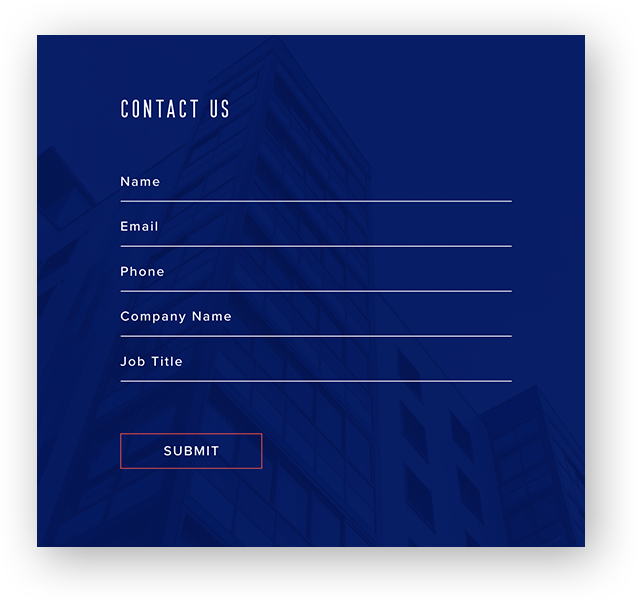
If you are using certain marketing automation software like HubSpot, you have the opportunity to add smart fields that will populate if you already have this particular information. Smart fields help expedite the lead qualification process by letting you ask for additional relevant information. These fields also make things easier for sales down the line if the lead becomes “sales qualified.”
Developing your questions
Gathering your teams together for your apartment lead generation strategy would be pointless if you don’t have a process by which to direct them. Thankfully, that process is relatively simple. Early in the multifamily inbound marketing process, your team should have come up with an ideal buyer profile and a buyer persona, as well as SMART goals for the year to determine what type of leads you are hoping to attract. Need help building your ideal buyer profile? Check out our other blog here.
At this time, you get to bring all those details together. By using lead and customer goals, persona details, and sales data, your team should be able to determine the necessary lead information to create marketing-qualified leads.
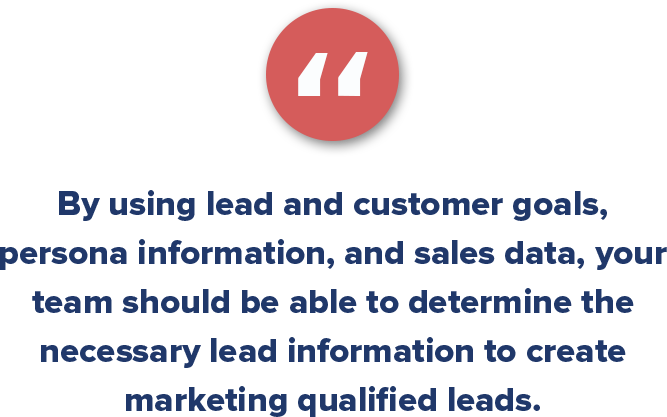
Back to the tenant rep example from above. You know the office building in question has a specific number of spaces with an anticipated rent range. You also know the amenities that the building does and does not have. Given the nature of the building, along with your business goals, you know you will likely need to build a large awareness funnel to meet the occupancy goals by open.
While your awareness questions are simple enough, the details you need in the consideration and decision stage are much more in-depth. For one, the type of business and size is important in determining fit, as the building may not support the needs of certain companies. If the building is high-end, questions around “current rent” or “monthly revenue” may be important to help you discover if the company is a good fit from an affordability standpoint. By gathering this information early on, when it comes time to start leasing, the tenant rep’s job should be fairly simple in picking sales-ready leads that met the requirements.
Segmenting your list
While the ultimate benefit of progressive profiling is to shorten the sales cycle, there’s a secondary benefit that can help. List segmentation is the act of separating contacts in your CRM by various criteria. If you run a multifaceted business with a lot of different verticals, list segmentation is a lifesaver.
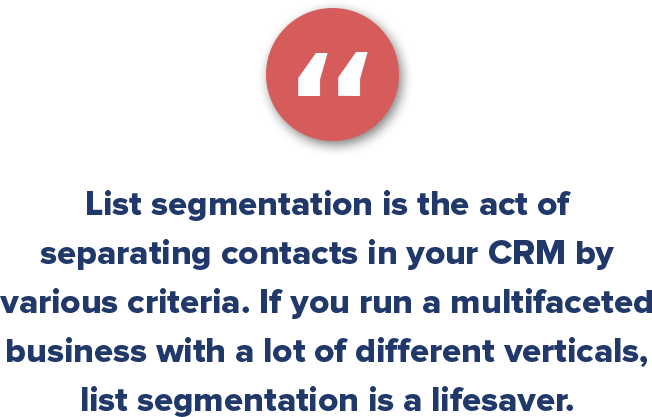
If you have a new offer for clients in the senior living space, for example, you don’t want to send it to the people in the economic development of mixed-use developments. Furthermore, people interested in your ad services probably aren’t interested in what you offer in multifamily branding. By gathering this information from apartment leads, you can use it to segment your multifamily marketing for a more streamlined message.
For content marketing success, an apartment lead generation form is much more complex than slapping a few fields on a page. Forms require a certain amount of business strategy to be used for their optimal effectiveness. This is a powerful tool that can improve the life of your sales cycle while requiring little more than some upfront strategy. All it takes is asking the right questions.
Millennials & the Multifamily Vendor Landscape: An Investment Primer
The multifamily industry is currently witnessing a massive demand upheaval, driven significantly by the millennial generation. As these young adults progress in their careers and start families, multifamily vendors, from property management software providers to developers, have a golden opportunity. But how can these vendors best navigate the evolving demands of this massive demographic?

Understanding the Millennial Shift
Millennials are the largest generation in America, with about 92 million people outpacing Gen Z, Gen X, and Baby Boomers. This generation, renowned for challenging the status quo, has redefined several societal norms. They’re choosing to tie the knot later — only 28% were married between the ages of 18 and 33 in 2014, as opposed to 49% of Baby Boomers at the same age. This delay in traditional milestones extends to having children as well.
For multifamily vendors, this demographic alteration is a clarion call. Between Q1 2020 and Q1 2022, new households swelled by 1.6 million, largely constituted by millennials. Their preference for larger suburban spaces with access to top-tier schools is clear, but financial barriers and supply shortages present formidable challenges.
Market Dynamics: The Millennial Dilemma
The U.S. housing prices shot up by 18.3% from May 2021 to May 2022. With limited supply and intensifying competition, first-time homebuyers, predominantly millennials, face an uphill battle. Add to this, mortgage rates are soaring.
Considering these dynamics, multifamily vendors need to recognize a crucial fact: for many millennials, renting is not just a choice; it’s the only viable option. This generation is cornered by financial constraints on one side and their aspirations for a comfortable living on the other. They’re caught between a rock and a hard place, and multifamily vendors have the opportunity to be their solution.
Catering to the Millennial Renting Demand
So, how should multifamily vendors position themselves to capitalize on this trend? The answer lies in understanding and catering to millennial preferences:
- Embrace Technology: Millennials demand seamless digital experiences. Property management software providers should focus on intuitive user interfaces and incorporate features that allow easy online payments, maintenance requests, and community engagements.
- Amenities & Workspaces: With remote work becoming increasingly prevalent, multifamily developers and contractors can prioritize building coworking spaces within communities, catering to millennials who may not always work from a traditional office.
- Engage Online: Millennials research extensively online before making decisions. Ratings agencies and developers must ensure a robust online presence filled with reviews, testimonials, and immersive virtual tours.
- Prioritize Sustainability: This generation is environmentally conscious. Developers and contractors focusing on green building practices will find favor with millennial renters.
- Single-Family Rentals (SFRs): For millennials starting families, SFRs in suburban areas offer the ideal blend of space and affordability. Vendors should recognize the increasing value of such properties, given the barriers millennials face in buying stand-alone homes.
The Millennial Opportunity
In an economic landscape fraught with challenges, multifamily investments offer a beacon of stability, particularly in the vendor space. Millennial demand is not a fleeting trend; it’s a consistent shift backed by strong demographic data.
For vendors, the message is clear: now is the time to pivot, innovate, and cater your multifamily marketing efforts to this demographic. After all, people will always need a place to live, and millennials present a ripe opportunity for the industry with their unique challenges and aspirations.

Unlocking Success: The Critical Impact of Consistency in Content Marketing
We all know content marketing is king, but content is nothing without consistency. Organizations that produce engaging, steady content often achieve greater results. However, consistency is becoming an increasingly significant issue for many businesses.
With a solid content calendar, you can build stronger connections with your audience, hit touchpoints on the buyer’s journey, and position yourself as a trusted and valuable resource.

Why Is Content Marketing Consistency Important?
Grasping the attention of consumers has become a tough business. Traditional forms of mass marketing will no longer be an effective way to bring awareness to convert prospects into buyers.
Creating a few blogs or posting on social media here and there might help a prospective customer understand a topic better. Still, it will not help you hit all necessary touchpoints or build a meaningful relationship. If you are not a consistent content marketing creator, you are not fully connecting with your audience.
Consider your favorite actor, who probably stars in a few favorite movies. If she continues to select roles that you resonate with, eventually, you might find yourself interested in pretty much anything she is involved in. This is how to position your organization: as a well-known, trusted, and familiar resource consistently delivering great work.
How to Create a Strategy — and Stick to It
The solution to consistency is inbound marketing, a modern method that equips you to create content that drives buyer personas through your marketing funnel. The inbound marketing methodology will help guide the context your material should be used within and is based on four stages: attract, convert, close, and delight.
Attract
The attract stage is about building awareness and creating content that turns strangers into visitors. Thus, it would be best to focus primarily on blogs, social media, and white pages. The goal is to provide solutions to your persona’s problems. For example, for an urban apartment, you might write a blog highlighting “The Best Places to Eat Gelato” or “10 Interior Design Tips for a Loft Apartment.”
Convert
The convert stage is about converting visitors into leads. The type of content you are producing would be in the form of a call-to-action (CTA) or landing page. Create gated offers where viewers must provide minimal information valuable to your business (email, zip code, etc.). For example, offers can include infographics, fact sheets, eBooks, or how-to guides.
Close
In the close stage, your strategy should be all about turning leads into customers. In this stage, you should focus on your CRM, email, and workflows. It’s important to speak their language, meet their needs, and seal the deal.
Delight
In the delight stage, you will continue to provide value and show you care about your customers. In turn, they will become advocates and promoters for your business. Through social monitoring and surveys, you can see how satisfied your residents are, and if there is a problem, you can address it quickly. Happy customers are your best advocates for attracting new leads.
Knowing these stages and using them to create consistent and targeted content marketing can help you produce the right material in the right context for your persona.
The Key to Content Marketing Consistency
Running an inbound marketing campaign for your multifamily property can be difficult. Once you draft your buyer personas and map their journey, it’s time to create a campaign. But planning your social media calendar the first time is time-intensive, so we’ve put together this handy template to get you started.

In the world of digital marketing, it can be hard to know which tactic works best. These days, a lot of businesses mistakenly focus too much of their digital marketing efforts on one specific tactic like blogging or social media.

However, each part of your digital marketing strategy should fit together as one cohesive piece. Your website, social media presence, user experience (UX), customer experience (CX), etc. should all work together to create a successful inbound marketing plan.
Bring Them to You
Digital marketing and specifically inbound marketing is all about the consumer. However, it’s not about bombarding them with interruptive advertisements. It’s about providing relevant and helpful information to your customers. The internet has truly changed the flow of advertising because consumers are now able to research a product before making a purchase.
As a marketing professional, it’s important to think of yourself more as a resource than a salesperson. People will want to come to you if you’re providing the right kind of information. When people see you as an asset, they’ll feel a sense of trust.
Research Your Audience
The first thing you need to do to serve as this resource to your consumer is to identify your audience. A multifamily property in downtown Dallas may know that a typical resident is a young professional between the ages of 23 and 30, but that doesn’t tell the whole story. Using market research, you can analyze who your target market is beyond the typical demographics, and begin to understand their needs, their pain points, and where they might seek out information.
A combination of market research and customer interviews can help you create buyer personas. Per HubSpot, a buyer persona is the creation of a semi-fictional profile. The persona profile should include a narrative of day-to-day interactions, demographic behavior, goals, pain points, what his/her search process has been, the type of experience desired, common objections, and a photo of your persona.
Most businesses have multiple buyer personas to understand the full scope of the audience that uses their product or service. Having a unique profile for each persona is important. Your buyer personas should inform everything you do and are integral to your digital marketing strategy.
The Perfect Content
Once you have a persona, the next step is attracting people through content creation. According to HubSpot, businesses should focus on “creating quality content that pulls people toward your company and product, where they naturally want to be. By aligning the content you publish with your customer’s interests, you naturally attract inbound traffic that you can then convert, close, and delight over time.”
Now here’s the caveat: According to SingleGrain, you should be spending about 80% of your time promoting your content and 20% of your time creating it. Think about it, If you have the world’s best content but people aren’t seeing it, what’s the point? It’s like the old adage about a tree falling in the forest when no one’s around to hear it — did it really fall? While creating relevant content is incredibly important, it’s the promotion of that content that is imperative.
Now, this is where the other elements of your digital marketing strategy can come into play. Each of these tactics should work together to build a well-rounded digital marketing campaign. These tactics are more effective in working together because the inbound methodology builds on each tactic to create a strategy.
Digital Marketing Elements: Email, Web, Social Media
Email marketing, for example, is considered to be one of the strongest tactics for nurturing leads. Integrating a strong email campaign into your digital marketing strategy is an important part of converting leads to leases. However, it’s most effective when pushing out sharable content that will lead customers down a purchase path.
Email marketing is also a great tool for tracking your target market so you can inform your content strategy. Based on the number of email opens and the clickthrough rate, you can see what kind of material your prospects are interested in.
This is also the case on your website. Automation allows you to track what your website visitors are doing on your site. Using this newly gathered information, you can help move leads along in a more personalized and effective way.
Knowing the content your audience is interested in is also helpful in social media as you’re able to show them what they want to see. Your user experience (UX) and customer experience (CX) also tie into this notion. The better the experience your potential clients have, the more interest they will have in moving forward with you. The same works for existing clients. About 83% of customers who experience positive interactions with brands are willing to offer referrals.
The integration of all aspects of the inbound methodology will differentiate you from the competition. You need more than a few social media pages or an automated email campaign to be successful. A full digital marketing strategy includes these elements and builds on them as a part of a comprehensive plan. It’s the combination of these strategies that will truly make your digital marketing strategy successful.

Understanding Millennials: A Generation Shaping Multifamily Marketing
In the ever-evolving landscape of the multifamily industry, staying attuned to shifting demographic trends is paramount for success. Among the most influential demographics shaping the market are millennials — individuals born between the early 1980s and mid-1990s.
With their unique preferences, values, and behaviors, millennial renters have become a driving force in shaping your multifamily marketing plan.
Understanding Millennial Renter Preferences
- Embracing Technological Connectivity: Millennials have grown up in a digital age, where technology is deeply embedded in their lives. They rely on smartphones, tablets, and social media platforms to stay connected, conduct research, and make purchasing decisions. As a multifamily marketer, harnessing the power of technology and embracing digital marketing strategies is crucial to engage with millennial renters effectively.
- Prioritizing Experiences Over Ownership: Unlike previous generations, millennials emphasize experiences more than material possessions. This mindset extends to their housing choices, as many millennials prefer the flexibility and convenience of renting over the commitment of homeownership. Highlighting the experiential aspects of your multifamily properties, such as amenities, community events, and convenient locations, can be key selling points to attract millennial renters.
- Sustainability and Environmental Consciousness: Millennials are environmentally conscious and seek sustainable living options. Incorporating eco-friendly features into your multifamily properties, such as energy-efficient appliances, recycling programs, and green spaces, can resonate with millennial renters who value sustainability. Communicating your commitment to sustainable practices can differentiate your property and attract environmentally conscious millennials.
- Authenticity and Transparency: Millennials value authenticity and are adept at detecting multifamily marketing gimmicks. They seek transparency in brand messaging and prefer genuine interactions. Building trust through honest and transparent communication is crucial in multifamily marketing. Share authentic stories, highlight the unique aspects of your properties, and engage with millennials through personalized and meaningful interactions.
Multifamily Industry Implications
- Shift in Property Amenities: Millennial preferences have led to a shift in property amenities. Millennial renters increasingly seek out fitness centers, communal workspaces, outdoor recreational areas, pet-friendly facilities, and smart home technology. Incorporating these amenities into your multifamily properties can attract and retain this target demographic.
- Rise of Digital Multifamily Marketing: Traditional marketing channels are no longer sufficient to reach millennial renters. Digital marketing, including social media for apartments, influencer partnerships, and targeted online campaigns, has become instrumental in effectively engaging with this tech-savvy generation. Investing in a comprehensive digital marketing strategy can yield significant results in attracting millennial renters.
- Enhanced Community Engagement: Millennials value community and social connections. Creating opportunities for community engagement within your multifamily properties, such as hosting resident events, organizing volunteer activities, or facilitating social platforms for residents to connect, can foster a sense of belonging and enhance the overall resident experience.

The Technology Factor
Millennials are the first generation to grow up around the internet. Interconnectivity and information explain much of what makes millennials who they are. By looking at specific digital trends among millennials, we can understand what drives their behavior and how they make purchase decisions. Because of their large purchasing power, marketers are changing their tactics to get in front of this generation. New social media advertising tactics have evolved due to millennials spending more than three hours a day on mobile phones.
While millennials are evolving online marketing, their lifestyles define the multifamily space. As millennials tend to wait longer for marriage and kids, they delay homeownership and rent longer. Multifamily communities have to adjust their marketing tactics to attract these sought-after renters.
Understanding Millennial Renters to Craft an Effective Multifamily Marketing Plan
Understanding millennial trends is crucial for developing an effective multifamily marketing plan. By embracing technology, prioritizing experiences, emphasizing sustainability, and cultivating authenticity, you can align your marketing efforts with the preferences and values of millennial renters.
Leveraging these insights can help differentiate your multifamily properties in a competitive market, attract millennial renters, and position your brand for long-term success. Stay attuned to evolving millennial trends, adapt your marketing strategies accordingly, and embrace the transformative opportunities presented by this influential generation within the multifamily industry.


